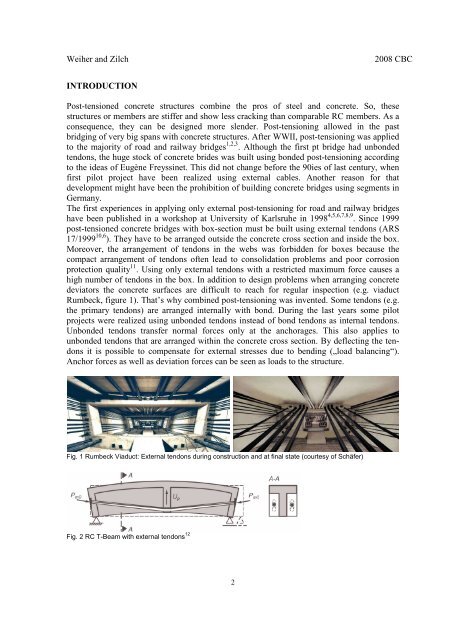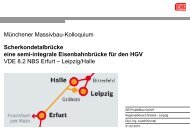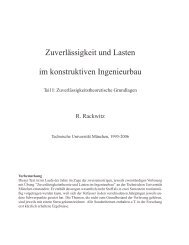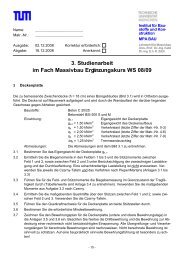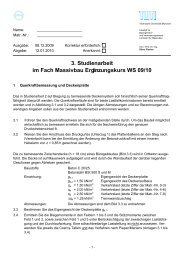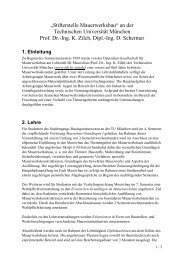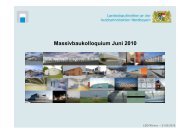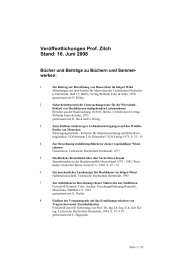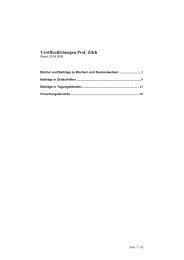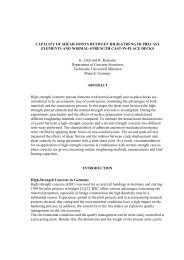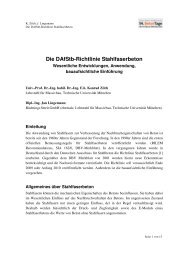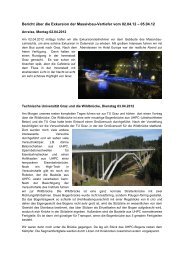Weiher and Zilch - Lehrstuhl für Massivbau
Weiher and Zilch - Lehrstuhl für Massivbau
Weiher and Zilch - Lehrstuhl für Massivbau
Create successful ePaper yourself
Turn your PDF publications into a flip-book with our unique Google optimized e-Paper software.
<strong>Weiher</strong> <strong>and</strong> <strong>Zilch</strong> 2008 CBC<br />
INTRODUCTION<br />
Post-tensioned concrete structures combine the pros of steel <strong>and</strong> concrete. So, these<br />
structures or members are stiffer <strong>and</strong> show less cracking than comparable RC members. As a<br />
consequence, they can be designed more slender. Post-tensioning allowed in the past<br />
bridging of very big spans with concrete structures. After WWII, post-tensioning was applied<br />
to the majority of road <strong>and</strong> railway bridges 1,2,3 . Although the first pt bridge had unbonded<br />
tendons, the huge stock of concrete brides was built using bonded post-tensioning according<br />
to the ideas of Eugène Freyssinet. This did not change before the 90ies of last century, when<br />
first pilot project have been realized using external cables. Another reason for that<br />
development might have been the prohibition of building concrete bridges using segments in<br />
Germany.<br />
The first experiences in applying only external post-tensioning for road <strong>and</strong> railway bridges<br />
have been published in a workshop at University of Karlsruhe in 1998 4,5,6,7,8,9 . Since 1999<br />
post-tensioned concrete bridges with box-section must be built using external tendons (ARS<br />
17/1999 10,6 ). They have to be arranged outside the concrete cross section <strong>and</strong> inside the box.<br />
Moreover, the arrangement of tendons in the webs was forbidden for boxes because the<br />
compact arrangement of tendons often lead to consolidation problems <strong>and</strong> poor corrosion<br />
protection quality 11 . Using only external tendons with a restricted maximum force causes a<br />
high number of tendons in the box. In addition to design problems when arranging concrete<br />
deviators the concrete surfaces are difficult to reach for regular inspection (e.g. viaduct<br />
Rumbeck, figure 1). That’s why combined post-tensioning was invented. Some tendons (e.g.<br />
the primary tendons) are arranged internally with bond. During the last years some pilot<br />
projects were realized using unbonded tendons instead of bond tendons as internal tendons.<br />
Unbonded tendons transfer normal forces only at the anchorages. This also applies to<br />
unbonded tendons that are arranged within the concrete cross section. By deflecting the tendons<br />
it is possible to compensate for external stresses due to bending („load balancing“).<br />
Anchor forces as well as deviation forces can be seen as loads to the structure.<br />
Fig. 1 Rumbeck Viaduct: External tendons during construction <strong>and</strong> at final state (courtesy of Schäfer)<br />
Fig. 2 RC T-Beam with external tendons 12<br />
2


